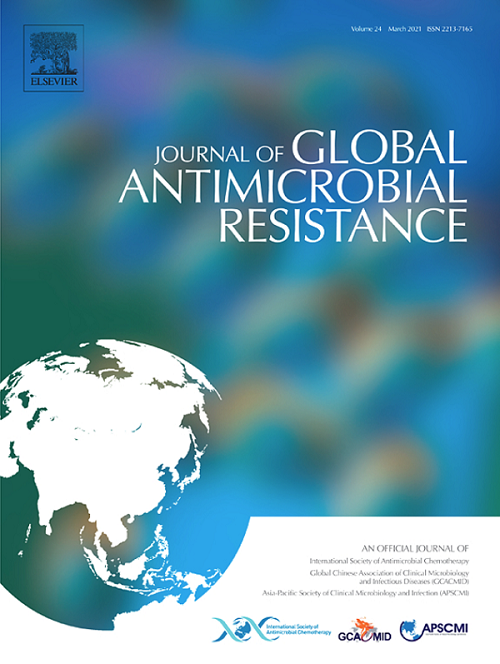合成林可酰胺类药物伊博霉素和链霉素对携带erm基因的眼部耐多药甲氧西林金黄色葡萄球菌有活性。
IF 3.7
3区 医学
Q2 INFECTIOUS DISEASES
引用次数: 0
摘要
目的:抗菌药耐药性是一种全球性流行病,对视力健康构成重大威胁,因为眼部细菌,尤其是耐甲氧西林金黄色葡萄球菌(MRSA)对一线疗法的耐药性越来越强。在此,我们对新型合成林可酰胺类药物的抗菌活性进行了评估,并与目前使用的抗生素进行了比较,以了解其对临床眼部 MRSA 分离物的抗菌活性:方法:通过肉汤微量稀释法对两种新型合成林可酰胺类药物(伊博霉素和链霉素)和 8 种比较抗生素进行抗菌药敏感性测试,测试对象为 50 个具有基因组特征的眼部 MRSA 分离物,包括携带 erm 基因的分离物(n=25):结果:两种药物对广泛存在的MRSA克隆复合体CC8和CC5都有活性。伊博霉素的 MIC50 和 MIC90 分别为 0.06 毫克/升和 2 毫克/升。克雷霉素(MIC50 = 0.06 mg/L)也显示出良好的活性,其体外效力(MIC90 = 0.5 mg/L)是伊博霉素的 4 倍。在携带erm基因的分离物中,克林霉素、伊博霉素和链霉素的MIC90分别大于16、2和0.5毫克/升。与克林霉素相比,伊博霉素和克雷霉素的体外药效与比较药相似或更高,且不受多重耐药表型或erm基因存在的影响:我们的研究结果表明,伊博霉素和克雷霉素对眼部MRSA分离株(包括携带erm基因的耐多药分离株)具有很强的体外活性。本文章由计算机程序翻译,如有差异,请以英文原文为准。
Synthetic lincosamides iboxamycin and cresomycin are active against ocular multidrug-resistant methicillin-resistant Staphylococcus aureus carrying erm genes
Objective
Antimicrobial resistance is a global pandemic that poses a major threat to vision health as ocular bacteria, especially methicillin-resistant Staphylococcus aureus (MRSA), are becoming increasingly resistant to first-line therapies. Here we evaluated the antimicrobial activity of new synthetic lincosamides in comparison to currently used antibiotics against clinical ocular MRSA isolates.
Methods
Antimicrobial susceptibility testing was performed by broth microdilution for two novel synthetic lincosamides (iboxamycin and cresomycin) and eight comparator antibiotics against a collection of 50 genomically characterised ocular MRSA isolates, including isolates harbouring erm genes (n = 25).
Results
Both drugs were active against widespread MRSA clonal complexes CC8 and CC5. The MIC50 and MIC90 of iboxamycin were 0.06 and 2 mg/L, respectively. Cresomycin (MIC50 = 0.06 mg/L) also displayed good activity with an in vitro potency four-fold higher (MIC90 = 0.5 mg/L) than iboxamycin. In isolates harbouring erm genes, MIC90 were >16, 2, and 0.5 mg/L for clindamycin, iboxamycin, and cresomycin, respectively. The in vitro potencies of iboxamycin and cresomycin were similar or higher than that of comparator agents and were not impacted by multidrug-resistance phenotypes or by the presence of erm genes when compared with clindamycin.
Conclusions
Our results demonstrate that iboxamycin and cresomycin display potent in vitro activity against ocular MRSA isolates, including multidrug-resistant isolates harbouring erm genes.
求助全文
通过发布文献求助,成功后即可免费获取论文全文。
去求助
来源期刊

Journal of global antimicrobial resistance
INFECTIOUS DISEASES-PHARMACOLOGY & PHARMACY
CiteScore
8.70
自引率
2.20%
发文量
285
审稿时长
34 weeks
期刊介绍:
The Journal of Global Antimicrobial Resistance (JGAR) is a quarterly online journal run by an international Editorial Board that focuses on the global spread of antibiotic-resistant microbes.
JGAR is a dedicated journal for all professionals working in research, health care, the environment and animal infection control, aiming to track the resistance threat worldwide and provides a single voice devoted to antimicrobial resistance (AMR).
Featuring peer-reviewed and up to date research articles, reviews, short notes and hot topics JGAR covers the key topics related to antibacterial, antiviral, antifungal and antiparasitic resistance.
 求助内容:
求助内容: 应助结果提醒方式:
应助结果提醒方式:


